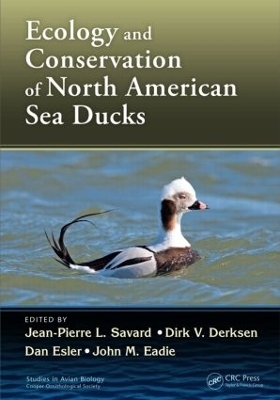
Ecology and Conservation of North American Sea Ducks
Crc Press Inc (Verlag)
978-1-4822-4897-5 (ISBN)
Chapters are organized conceptually to focus on, compare, and contrast the ecological attributes of the tribe. Experts provide in-depth treatments of a range of topics, including:
Population dynamics and genetics
Infectious diseases and parasites
Breeding costs and cross-seasonal affects
Contaminant burdens
Foraging behavior and energetics
Migration strategies, molt ecology, and habitat affinities and dynamics
Breeding systems and reproductive behavior
Harvest history
The book presents a comprehensive synthesis of sea duck ecology, documents factors that have caused population declines of some species, and provides managers with measures to enhance recovery of depressed populations of sea ducks in North America. Capturing the current state of knowledge of this unique tribe, it provides a benchmark for where we are in conservation efforts and suggests future directions for researchers, managers, students, conservationists, and avian enthusiasts.
Jean-Pierre L. Savard is a scientist emeritus with Environment Canada, Quebec, Canada. Dr. Savard earned his PhD from the University of British Columbia, where he conducted research on the territorial behavior, nesting success, and brood survival of Barrow’s Goldeneye, Common Goldeneye, and Bufflehead Ducks. He has published numerous papers focused on the biology and population dynamics of sea ducks including Common Eider, Harlequin Duck, Surf Scoter, Black Scoter, Long-Tailed Duck, Bufflehead, Barrow’s Goldeneye, Common Goldeneye, Hooded Merganser, and Red-Breasted Merganser. Dirk V. Derksen is retired from the U.S. Geological Survey, Alaska Science Center, Anchorage, Alaska, where he served as chief of migratory bird, terrestrial mammal, and genetics research over a 26-year period. Dr. Derksen earned his PhD from Iowa State University and conducted his dissertation research on Adelie penguins in Antarctica. He studied habitat ecology of waterbirds on the North Slope of Alaska and published a suite of papers detailing the freshwater and marine wetland and terrestrial areas important for Spectacled Eiders, King Eiders, and Long-Tailed Ducks. Daniel Esler is a research wildlife biologist with the U.S. Geological Survey, Alaska Science Center, Anchorage, Alaska, where he leads ecological studies of nearshore marine systems along the Pacific Coast of North America. Dr. Esler examined the effects of the 1989 Exxon Valdez oil spill on the demography of Harlequin Ducks during winter in Prince William Sound, Alaska, for his PhD at Oregon State University. He has published extensively on the biology of sea ducks including Steller’s Eider, Spectacled Eider, Harlequin Duck, Surf Scoter, White-Winged Scoter, Black Scoter, and Barrow’s Goldeneye. John M. Eadie is Dennis G. Raveling Professor in Waterfowl Biology and chair of the Department of Wildlife, Fish & Conservation Biology, University of California, Davis, California. Dr. Eadie earned his PhD in zoology at the University of British Columbia, where he researched the reproductive ecology and behavior of Barrow’s and Common Goldeneyes. His numerous publications cover a diversity of behavioral and ecological aspects of sea duck species including Steller’s Eider, Harlequin Duck, Surf Scoter, Bufflehead, Barrow’s Goldeneye, and Common Goldeneye.
Status and Trends of North American Sea Ducks: Reinforcing the Need for Better Monitoring. Phylogenetics, Phylogeography, and Population Genetics of North American Sea Ducks (Tribe: Mergini). Population Dynamics of Sea Ducks: Using Models to Understand the Causes, Consequences, Evolution, and Management of Variation in Life History Characteristics. Infectious Diseases, Parasites, and Biological Toxins in Sea Ducks. Dealing with Deficits: Breeding Costs, Nutrient Reserves, and Cross-Seasonal Effects in Sea Ducks. Metals and Trace Elements, Petroleum, Organic Pollutants, and Radiation in Sea Ducks. Foraging Behavior, Ecology, and Energetics of Sea Ducks. Variation in Migration Strategies of North American Sea Ducks. Remigial Molt of Sea Ducks. Site Fidelity, Breeding Habitats, and the Reproductive Strategies of Sea Ducks. Breeding Systems, Spacing Behavior, and Reproductive Behavior of Sea Ducks. Harvest of Sea Ducks in North America: A Contemporary Summary. Habitats of North American Sea Ducks. Conservation of North American Sea Ducks. Conclusions, Synthesis, and Future Directions: Understanding Sources of Population Change. Appendix A: North American Sea Ducks. Index.
| Reihe/Serie | Studies in Avian Biology |
|---|---|
| Zusatzinfo | 42 Tables, black and white; 16 Illustrations, color; 107 Illustrations, black and white |
| Verlagsort | Bosa Roca |
| Sprache | englisch |
| Maße | 178 x 254 mm |
| Gewicht | 1312 g |
| Themenwelt | Sachbuch/Ratgeber ► Natur / Technik ► Natur / Ökologie |
| Naturwissenschaften ► Biologie ► Evolution | |
| Naturwissenschaften ► Biologie ► Ökologie / Naturschutz | |
| Naturwissenschaften ► Biologie ► Zoologie | |
| ISBN-10 | 1-4822-4897-2 / 1482248972 |
| ISBN-13 | 978-1-4822-4897-5 / 9781482248975 |
| Zustand | Neuware |
| Haben Sie eine Frage zum Produkt? |
aus dem Bereich


